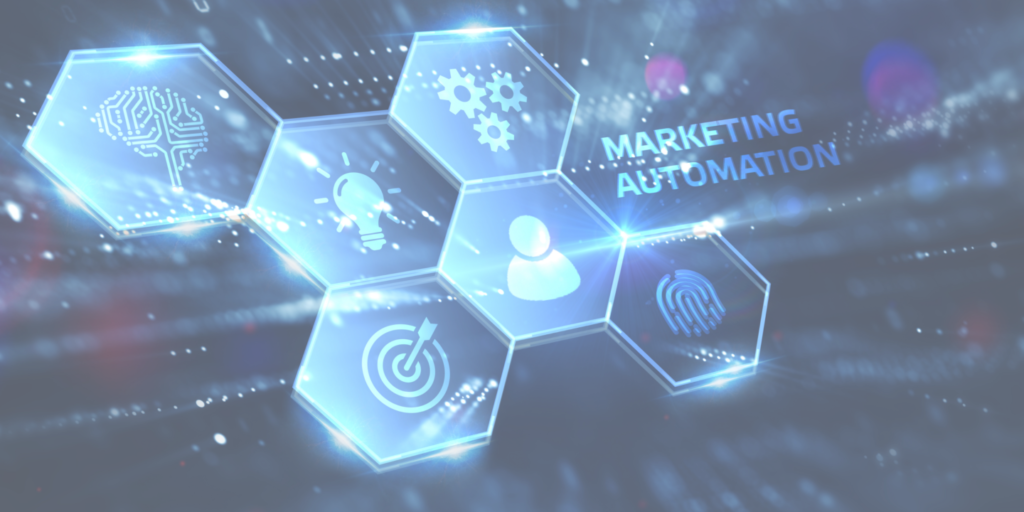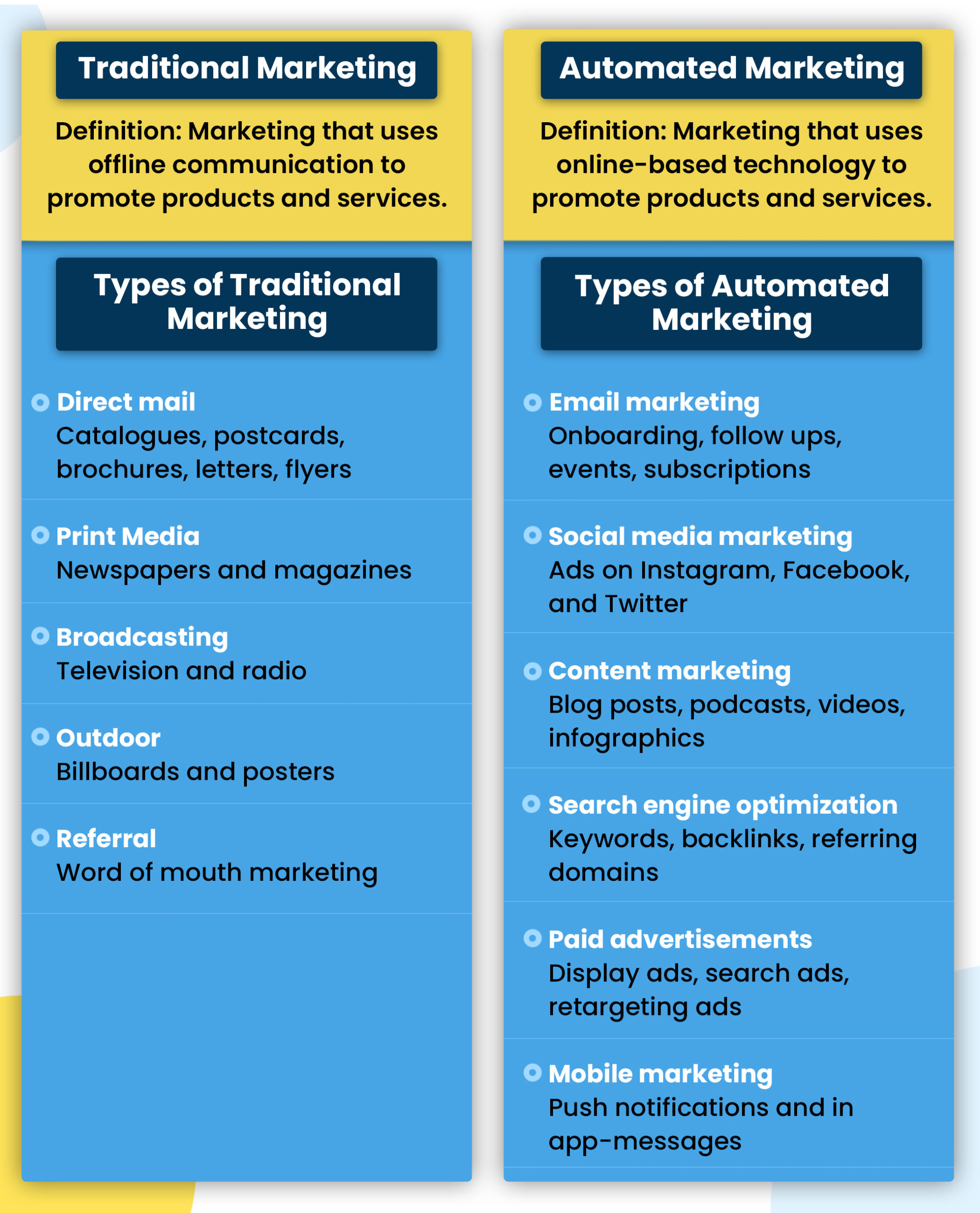We’re living in a digital age and marketing is changing rapidly.
Despite all of the innovations, one thing remains — marketing is tricky. While the basic concepts of marketing haven’t changed, methods are getting more complex. This is due in part to the rise of algorithms, policy adjustments, and evolving consumer behavior.
To adapt to these changes, market automation has become a key tactic for marketers. It simplified workflows and made analytics easier to understand.
And it’s no secret that behavior based marketing automation has become a go-to method for marketers and business owners.
Experts even predict that the global marketing automation market size is expected to hit $25 billion by 2023.
How can you hop on the automated marketing train in 2022? We’ve outlined a guide for everything you need to know about how to improve your automated marketing.
Today we go over:
- Examples of consumer-based automated marketing
- Which marketing automation is optimal
- The impact automated marketing has on the customer journey
Different Types of Behavioral Based Marketing Automation
Behavioral marketing includes various digital marketing strategies across multiple channels. Here are a few of the most common:
Trigger-Based Automation
Trigger marketing is a technique that triggers an automatic message based on an action or inaction from the customer.
Email automation is the most common use of behavioral market automation. Tools can help with sequencing and triggering emails based on customer behaviors.
An example would be triggering transactional emails following a purchase or activating reminder emails for those who still have items in their cart.
Another example of trigger-based automation is SMS marketing. Like email marketing, this method automatically sends messages based on a customers’ behavior.
For instance, if a gym member signs up for a class, a welcome or confirmation text message will trigger.
Profile-Based Targeting
Profile-based targeting is another example you’re probably familiar with. Social media platforms like Instagram and Facebook are notorious for showing targeted ads based on users’ interests.
For example, if a user visits a page for luxury watches, the platform will target them and show ads for watches.
Social media platforms like Facebook allow brands to create ads based on certain criteria for a specific audience. In addition, the Facebook Ad algorithm automates the profile-based ad targeting process.
You can do the same thing with market automation tools. For example, through integration with customer data in your CRM, you can display relevant messages to specific site visitors.
Personalization
Automatic personalization is one of the most engaging and effective marketing strategies.
You probably have a few automated personalizations sitting in your inbox right now. An example of an automated personalized message would be a product recommendation email from Amazon or movie suggestions from Netflix.
Companies like these use customer behavior, buying patterns, and feedback to recommend content or products that they might like.
Automated personalizations ensure that consumers see content that is relevant to them.
Best Practices for Behavioral Marketing Automation
How can you make the most behavioral marketing automation? We’ve provided best practices to give you a framework to use when planning out your automated marketing campaign.
Collect the Right Data
The magic of automated marketing is rich data. What do we mean by rich data? Don’t just collect the standard information like name, date of birth, and email address. Instead, aim to gain customer insights as they interact with your brand.
This behavioral data includes what content users engage with and any purchase they make or don’t make. This gives you an idea about what a customer is interested in.
With the data you collect, you can create segmented lists and craft different automated journeys made for them.
Establish Lead Scoring
A lead scoring system allows you to identify which prospects are the most valuable to your business.
First, assign different actions a numerical value, depending on their significance. Actions could be anything from clicking a link to subscribing to your email list.
Then, using an algorithm, assign points to leads based on their actions. The score will tell you how likely they are to become customers.
Create Multi-Channel Experiences
To use automation workflows to their fullest potential, integrate other channels.
Using only one medium means missed opportunities to reach customers in various ways. And depending on your marketing message, more than one channel might be better than others.
For example, SMS marketing gets your message delivered faster than email. This makes it practical for time-sensitive messages like follow-ups or appointment reminders. Of course, you can also combine the two mediums.
Let’s say you’re creating an automated workflow for a walkathon event. You might start with automated emails sharing details about the event and then use an SMS message as a final reminder. And after the event, you could send a thank you text message with a request to fill out a survey.
To give you an idea of what a behavioral-based marketing campaign would look like, we’ve highlighted three examples — some of which you’re probably already familiar with.
Share Relevant Information
As we already know, email marketing allows businesses to use audience segmentation based on previous engagement to send customized messages.
What’s the big deal about customized content? Consumers are more willing to engage with personalized content than random ads.
In fact, 80 percent of consumers are more likely to make purchases from brands that offer personalized experiences.
Hulu: Personalized TV Show Recommendations
Hulu’s “Top Picks” automated email is an example of customized content. The message contains TV show recommendations based on the users’ preferences, browsing behavior, and watch history.
Neutrogena: You Might Also Like
Another common type of behavior marketing tactic is suggested selling. And if you’ve browsed an e-commerce store, chances are you’ve seen this before.
This involves tracking customer purchasing behavior data and suggesting new products they might be interested in.
Below is an example from Neutrogena. The list of recommended products is generated after a website visitor clicks on a particular type or product line.
Offer Proactive Customer Support
While it’s common to use automation for positive events like signups or completed transactions, you can also use automation to identify negative events, like a common behavioral roadblock.
For example, you can set a chat trigger to identify and respond when a website visitor has items in their cart or when they’re lingering on the checkout page.
Let’s say a visitor spends too much time on a specific product page. This could mean they need assistance. You can also set a chatbot to proactively reach out if they need help.
Below is a chatbot demonstration from Peloton. A proactive message is triggered after a visitor lingers on a page for some time.

A chatbot trigger is also great for your pricing or packages page. If a visitor has made it to this section, it means they’re interested in your services, and they want to learn more. A chatbot could help answer questions and move them closer to converting.
Here are two examples of conversational proactive chat messages:
- “Hey! Have questions about our pricing? We’re here to help.”
- “Having trouble choosing the best membership package for you?”
Keep your customers engaged with our chatbot tool. You can set it to provide personalized customer support and collect valuable data.
VIP Rewards Program
It’s simple to set up a series of automated emails that make your customers feel valued after they make a purchase.
Most rewards programs assign customers a certain amount of points for every dollar they spend. And they have to achieve a specific threshold before redeeming those points for discounts and bonuses.
Sephora’s VIB (Very Important Beauty) Program is the perfect example of this. Customers who spend a certain amount of money become eligible for special promotions.
Once a customer spends the required amount, they’re entered into the VIB segment of the email list.

You can do something similar to this program using data about customer behavior. For example, if a member refers a certain amount of people to your gym, they’ll trigger the VIP customer journey.
Tools to Help You With Intelligent Marketing Automation
All you have to do is collect information about your customer’s preferences and create tailored messages. Easy, right? Not exactly.
Although it may sound simple, many brands struggle with data collection. Check out the results from Experian:
- 40 percent of marketers say their biggest challenge is linking data-related technologies.
- 34 percent struggle with poor data quality.
- 78 percent of brands say they don’t have enough data about their customers.
What is the answer to this data dilemma? Integrative automated marketing tools.

All of our marketing solutions seamlessly integrate with a variety of other platforms. Our business intelligence system efficiently organizes data from your CRMs tools. It allows you to measure customer lifetime value, churn rate, and growth rate.
Our tools also help you set up lead scoring to identify your most profitable customers.
How to Set Up An Intelligent Marketing Automation Campaign
Now that you’ve chosen the right tool for your automated marketing campaign, it’s time to strategize. Here’s how to get started:
Plan Your Touchpoints
The first step is to figure your outreach in a logical sequence. Then, you can include multiple channels in your campaign. They would look something like this:
- An email providing informational content about your brand — this could be a list of fitness class offerings with descriptions.
- Another email highlighting success stories from your members.
- A text or email announcing a discount on a yearly gym membership.
Ensure that each touchpoint has a call-to-action so that your lead moves closer to a conversion.
Which Behavior Triggers Which Action
You want to determine triggers based on how your customers interact with your business. For instance, you can resend emails to non-openers or send emails to customers who have the highest average engagement.
How Does Behavioral Automation Affect the Customer Journey?
Believe it or not, but automation personalizes the modern customer journey.
How so? Brands can collect behavioral data of interactions across multiple channels with marketing automation. You can also look at patterns and group customers into segments.
And because of this approach, messaging can be tailored, giving the customer a unique and personal path towards a purchase.
Summary
Personalizing your marketing based on how customers interact with your brand isn’t new. But doing so in a quick and intuitive way can be a growing challenge.
However, our marketing automation tool for gyms allows business owners to connect existing data sources and bring them into one centralized view. Our software also sends automated communications across multiple mediums — including emails, SMS messages, and push notifications.
Schedule a FREE demo if you’re ready to simplify your customer data management.





